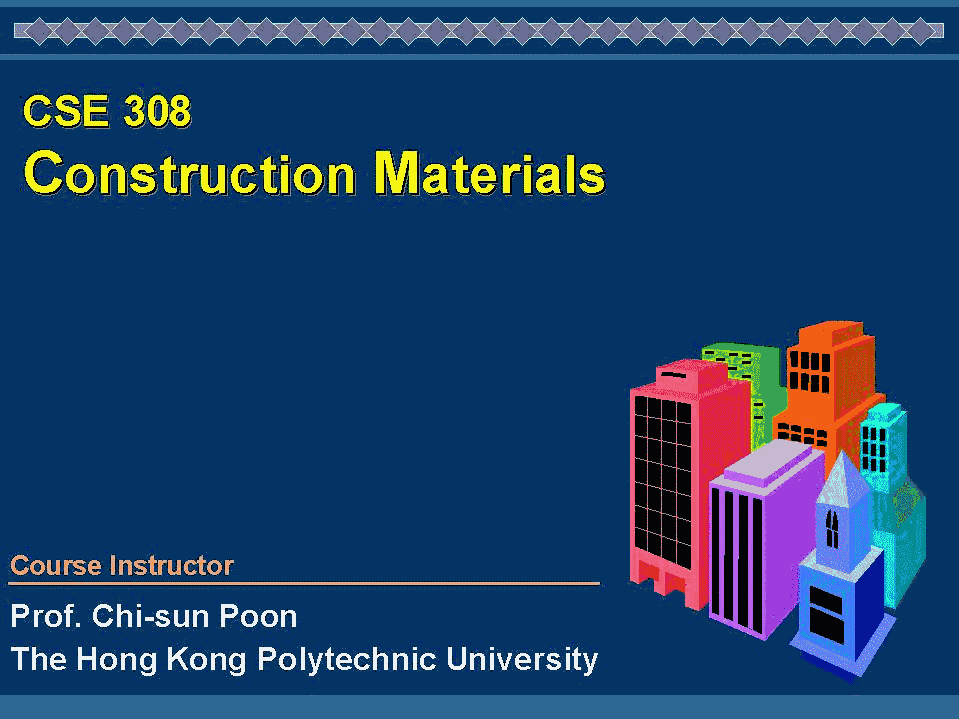| Course Layout:
Concrete
1. Introduction and Basic Concepts
Definition
Advantages of concrete as a construction material
Comparison between structural concrete and steel
Types of structural concrete
Constituent materials of concrete
Production of concrete – a brief review
Ready mixed concrete
2. Cement
Chemical composition of cement
Manufacture of Portland cement
Hydration of cement
Microstructure of hardened cement paste
Types of Portland cement
Tests to evaluate properties of cement
Factors affecting properties of cement
3. Aggregates
General classification of aggregates
Properties of good aggregates
Sampling and grading of aggregates (sieve analysis, grading curves, fineness
modulus)
Grading requirements
Physical and mechanical testing of aggregates
4. Properties of Fresh Concrete
Workability of concrete
Factors affecting workability
Measurement of workability
Problems in fresh concrete
Mixing, placing and compaction of concrete
5. Properties of Hardened Concrete
Measurement of compressive strength of concrete
Factors affecting compressive strength of concrete
Tensile strength of concrete
Flexural strength of concrete
Bond strength of concrete
6. Testing of Hardened Concrete
Compressive strength tests
Destructive tests (Cube test, Cylinder test, Core test)
Non-destructive tests (Rebound hammer, Penetration resistance, Pull-out,
Ultrasonic Pulse)
Tensile strength test
Flexural strength test
Relation between tensile strength and compressive strength
Bond strength
7. Admixtures
Concrete admixtures
Benefits of admixtures
Type of admixtures (Accelerators, Retarders, Water-reducers)
How the admixtures work in concrete?
Effect of admixtures on the properties of concrete
Mineral Admixtures
Benefits of mineral admixtures
Type of mineral admixtures (silica fume, fly ash, blast furnace slag)
Effect of mineral admixtures on the properties of concrete
8. Concrete Mix Design
Process of mix selection
Factors affecting the mix proportions
Mix design methods
British method
ACI Method
Absolute volume approach
Mix design of flowing concrete
Mix design of high performance concrete
9. Special Concretes
High performance concrete
High workability or self-compacting concrete
Lightweight concretes
Fiber reinforced concrete
Polymerized concretes
Ferrocement
Roller compacted concrete
Macro defect free concrete
Nailing concrete
10. Durability of Concrete
Permeability of concrete
Sulfate attack
Attack by sea water
Acidic attack
Alkali-silica reaction
Alkali-carbonate reaction
Corrosion of reinforcement
Deterioration by fire
Steel
1. Introduction and Basic Concepts
Advantages of steel construction
Chemical composition of steel
Steel production mechanism
Types of structural steel
Strengthening mechanisms of steel
2. Mechanical Properties and Testing of Steel
Tension
Stress-strain curve and its properties
Compression
Hardness
Impact
3. Ductility, Fatigue and Creep of Steel
Ductility of steel
Fatigue
Loadings for fatigue
The S-N curve
Improvement techniques
Creep
Creep behavior of steel
Testing the creep behavior
4. Durability of Steel Structures
Corrosion process of steel
Types of corrosion
Corrosion rate
Corrosion Protection
Fire properties of steel
Protection methods
|


